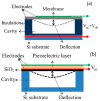Ultrasound Systems for Biometric Recognition
- PMID: 31137504
- PMCID: PMC6566381
- DOI: 10.3390/s19102317
Ultrasound Systems for Biometric Recognition
Abstract
Biometric recognition systems are finding applications in more and more civilian fields because they proved to be reliable and accurate. Among the other technologies, ultrasound has the main merit of acquiring 3D images, which allows it to provide more distinctive features and gives it a high resistance to spoof attacks. This work reviews main research activities devoted to the study and development of ultrasound sensors and systems for biometric recognition purposes. Several transducer technologies and different ultrasound techniques have been experimented on for imaging biometric characteristics like fingerprints, hand vein pattern, palmprint, and hand geometry. In the paper, basic concepts on ultrasound imaging techniques and technologies are briefly recalled and, subsequently, research studies are classified according to the kind of technique used for collecting the ultrasound image. Overall, the overview demonstrates that ultrasound may compete with other technologies in the expanding market of biometrics, as the different commercial fingerprint sensors integrated in portable electronic devices like smartphones or tablets demonstrate.
Keywords: biometrics; ultrasonic transducers; ultrasound imaging.
Conflict of interest statement
The author declares no conflict of interest.
Figures






References
-
- Jain A., Ross A., Prabhakar S. An Introduction to Biometric Recognition. IEEE Trans. Circuits Syst. Video Technol. 2004;14:4–20. doi: 10.1109/TCSVT.2003.818349. - DOI
-
- Jain A., Flynn P., Ross A. Handbook of Biometrics. Springer; Secaucus, NJ, USA: 2007.
-
- Lin C., Kumar A. Contactless and partial 3D fingerprint recognition using multi-view deep representation. Pattern Recognit. 2018;83:314–327. doi: 10.1016/j.patcog.2018.05.004. - DOI
-
- Bhairannawar S., Sarkar S., Raja K., Venugopal K. Implementation of Fingerprint Based Biometric System Using Optimized 5/3 DWT Architecture and Modified CORDIC Based FFT. Circuits Syst. Signal Process. 2018;37:342–366. doi: 10.1007/s00034-017-0555-0. - DOI
Publication types
MeSH terms
LinkOut - more resources
Full Text Sources
Other Literature Sources

